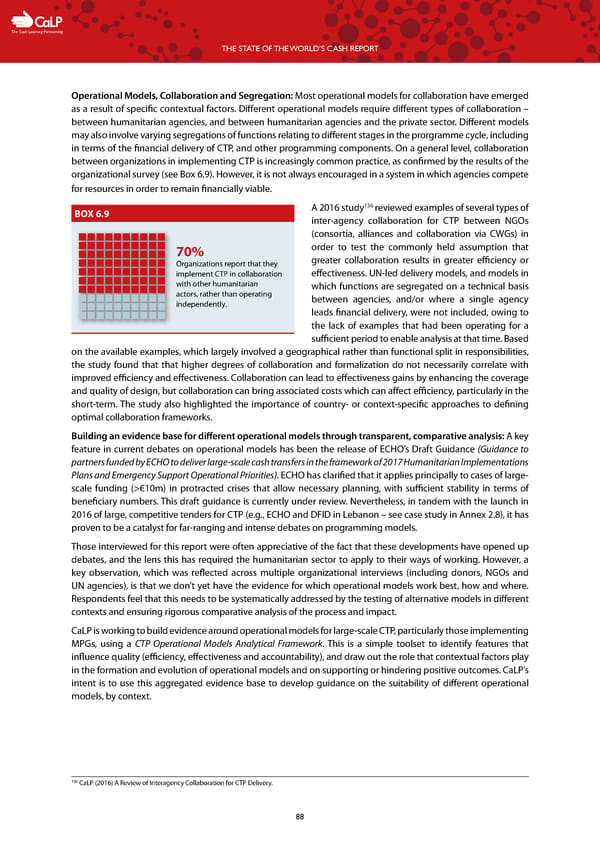C The Cash Learning Partnership THE STATE OF THE WORLD’S CASH REPORT Operational Models, Collaboration and Segregation: Most operational models for collaboration have emerged as a result of specific contextual factors. Different operational models require different types of collaboration – between humanitarian agencies, and between humanitarian agencies and the private sector. Different models may also involve varying segregations of functions relating to different stages in the prorgramme cycle, including in terms of the financial delivery of CTP, and other programming components. On a general level, collaboration between organizations in implementing CTP is increasingly common practice, as confirmed by the results of the organizational survey (see Box 6.9). However, it is not always encouraged in a system in which agencies compete for resources in order to remain financially viable. 136 BOX 6.9 A 2016 study reviewed examples of several types of inter-agency collaboration for CTP between NGOs (consortia, alliances and collaboration via CWGs) in 70% order to test the commonly held assumption that Organizations report that they greater collaboration results in greater efficiency or implement CTP in collaboration effectiveness. UN-led delivery models, and models in with other humanitarian which functions are segregated on a technical basis actors, rather than operating between agencies, and/or where a single agency independently. leads financial delivery, were not included, owing to the lack of examples that had been operating for a sufficient period to enable analysis at that time. Based on the available examples, which largely involved a geographical rather than functional split in responsibilities, the study found that that higher degrees of collaboration and formalization do not necessarily correlate with improved efficiency and effectiveness. Collaboration can lead to effectiveness gains by enhancing the coverage and quality of design, but collaboration can bring associated costs which can affect efficiency, particularly in the short-term. The study also highlighted the importance of country- or context-specific approaches to defining optimal collaboration frameworks. Building an evidence base for different operational models through transparent, comparative analysis: A key feature in current debates on operational models has been the release of ECHO’s Draft Guidance (Guidance to partners funded by ECHO to deliver large-scale cash transfers in the framework of 2017 Humanitarian Implementations Plans and Emergency Support Operational Priorities). ECHO has clarified that it applies principally to cases of large- scale funding (>€10m) in protracted crises that allow necessary planning, with sufficient stability in terms of beneficiary numbers. This draft guidance is currently under review. Nevertheless, in tandem with the launch in 2016 of large, competitive tenders for CTP (e.g., ECHO and DFID in Lebanon – see case study in Annex 2.8), it has proven to be a catalyst for far-ranging and intense debates on programming models. Those interviewed for this report were often appreciative of the fact that these developments have opened up debates, and the lens this has required the humanitarian sector to apply to their ways of working. However, a key observation, which was reflected across multiple organizational interviews (including donors, NGOs and UN agencies), is that we don’t yet have the evidence for which operational models work best, how and where. Respondents feel that this needs to be systematically addressed by the testing of alternative models in different contexts and ensuring rigorous comparative analysis of the process and impact. CaLP is working to build evidence around operational models for large-scale CTP, particularly those implementing MPGs, using a CTP Operational Models Analytical Framework. This is a simple toolset to identify features that influence quality (efficiency, effectiveness and accountability), and draw out the role that contextual factors play in the formation and evolution of operational models and on supporting or hindering positive outcomes. CaLP’s intent is to use this aggregated evidence base to develop guidance on the suitability of different operational models, by context. 136 CaLP (2016) A Review of Interagency Collaboration for CTP Delivery. 88
 The State of the World's Cash | Full Report Page 89 Page 91
The State of the World's Cash | Full Report Page 89 Page 91